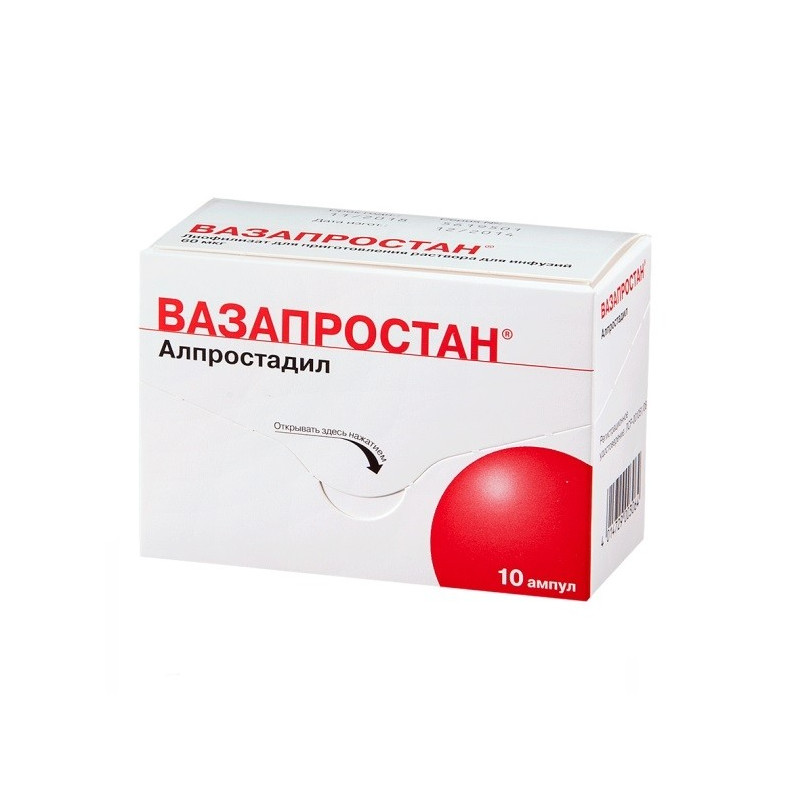



 All payments are encrypted via SSL
All payments are encrypted via SSL
 Full Refund if you haven't received your order
Full Refund if you haven't received your order
- chronic obliterating diseases of arteries of the III and IV stages (according to the Fontaine classification).
It is necessary to prepare the solution immediately before performing the infusion. The lyophilisate is dissolved immediately after the addition of saline. Initially, the solution may turn milky. This effect is created by air bubbles and does not matter. After a short time, the solution becomes clear.
Do not use the solution prepared more than 12 hours ago.
Nervous system: headache, dizziness, convulsive syndrome, increased fatigue, malaise, impaired sensitivity of the skin and mucous membranes.
Cardiovascular: decrease in blood pressure, chest pain, cardiac arrhythmias, AV-blockade.
Gastrointestinal: epigastric discomfort, nausea, vomiting, diarrhea.
Musculoskeletal system: hyperostosis of long tubular bones (with therapy for more than 4 weeks).
Allergic reactions: skin rash, itching.
Local reactions: erythema, edema, pain, impaired sensitivity, phlebitis (proximal to the place of / in the introduction).
Other: increased sweating, hyperthermia, swelling of the limb, into which the vein is infused.
Laboratory values: leukocytosis, leukopenia, an increase in the C-reactive protein titer, an increase in the level of transaminases.
Seldom: arthralgia, confusion, central seizure convulsions, fever, chills, bradypnea, psychosis, renal failure, anuria. Several cases of pulmonary edema and acute left ventricular failure have been reported.
Extremely rare (up to 1% of cases): shock, acute heart failure, hyperbilirubinemia, bleeding, drowsiness, bradypnea, decreased respiratory function, tachypnea, anuria, impaired renal function, hypoglycemia, ventricular fibrillation, AV-blockade II degree, supraventricular arrhythmia, neck muscle strain, irritation, irritability, hypothermia, skin hyperemia, hematuria, peritoneal symptoms, tachyphylaxis, hyperkalemia, thrombocytopenia, anemia.
The side effects associated with the use of the drug or with the catheterization procedure itself are reversible after dose reduction or cessation of the infusion.
- chronic heart failure in the stage of decompensation;
- pronounced cardiac arrhythmias;
- exacerbation of CHD;
- myocardial infarction transferred in the last 6 months;
- pulmonary edema;
- infiltrative lung disease;
- chronic obstructive pulmonary disease;
- liver dysfunction (increase in AST, ALT, GGT);
- a history of liver disease;
- diseases accompanied by an increased risk of bleeding (gastric ulcer and duodenal ulcer, severe damage to the brain vessels, proliferative retinopathy with a tendency to bleeding, extensive injury);
- concomitant therapy with vasodilator and anticoagulant drugs;
- pregnancy;
- lactation period (breastfeeding);
- age up to 18 years (efficiency and safety have not been established);
- hypersensitivity to alprostadil and other components of the drug.
WITH caution Vasaprostan should be prescribed for arterial hypotension, cardiovascular insufficiency (it is obligatory to control the load of the carrier volume), patients on hemodialysis (treatment should be carried out in the post-dialysis period), patients with type 1 diabetes, especially for extensive vascular lesions.
Vasaprostan can be used only by doctors who have experience in angiology, are familiar with modern methods of continuous monitoring of the cardiovascular system and have the appropriate equipment for this.
During treatment, Vasaprostan should monitor blood pressure, heart rate, blood biochemical parameters, blood clotting parameters (for violations of the blood coagulation system or for simultaneous therapy with drugs that affect the coagulation system).
Terms and conditions of storage
List B.The drug should be stored out of the reach of children at a temperature not higher than 25 ° C.
